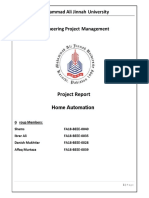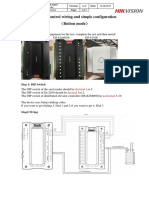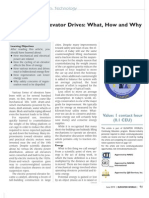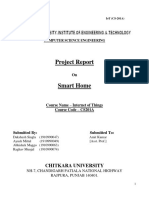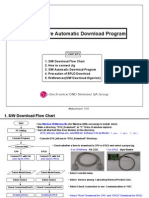Home Automation Using Arduino and IOT
Home Automation Using Arduino and IOT
Copyright:
Available Formats
Home Automation Using Arduino and IOT
Home Automation Using Arduino and IOT
Copyright
Available Formats
Share this document
Did you find this document useful?
Is this content inappropriate?
Copyright:
Available Formats
Home Automation Using Arduino and IOT
Home Automation Using Arduino and IOT
Copyright:
Available Formats
Volume 3, Issue 3, March– 2018 International Journal of Innovative Science and Research Technology
ISSN No:-2456-2165
Home Automation using Arduino and IOT
Priyanka G.Gawade Prajakta D.Jadhav
Department of Electronics and Telecommunication Department of Electronics and Telecommunication
Engineering. Engineering.
Sou. Sushila Danchand Ghodawat Charitable Trust's and Sou. Sushila Danchand Ghodawat Charitable Trust's and
Group Of Institutions Group Of Institutions
Kolhapur, Maharashtra, Kolhapur, Maharashtra,
India. India.
Madhavi B. Danane
Department of Electronics and Telecommunication Engineering.
Sou. Sushila Danchand Ghodawat Charitable Trust's and Group Of Institutions
Kolhapur, Maharashtra,
India.
Abstract:- Home automation is a Automation technology This paper is organized in following manner. Section I
which makes the work easier in all aspects related to home. starts with the brief introduction to our project that is home
There are different methods in wireless technology such as automation and the need to built it, Section II contains the
Bluetooth, WIFI and GSM.As we are entering in a new era existing work of home automation to control various
of technology home automation has more significance. appliances, security and control over it. Proceeding ahead,
Automated home is also called as smart home. In this Section III describes proposed system and it include system
paper we have presented a Home automation using overview. Finally, Section IV concludes research work with
Arduino and IOT. Our project proposes a low cost future directions.
solution and Home automation is done using IOT system
which uses mobile devices to control an analyze the basic II. RELATED WORK
home functions and features automatically through This home automation system includes MQ2 sensor
internet from any corner within short span of time. which detects the gas leakage in home such as LPG and gives
ATMEGA 328 arduino microcontroller is used to upload indication through the buzzer. PIR sensor is used to detect the
computer code to the physical board and controls sensors, presence of unknown person . The data of MQ2 sensor and
relays as well as actuators. PIR sensor is displayed on LCD and as well as on Webpage
through WIFI module. The initial conditions of these sensors
Keywords:- ATMEGA 328 microcontroller, WIFI module,
and home appliances can be controlled and changed with the
MQ2 gas leakage sensor, PIR sensor, Buzzer, LCD.
help of webpage which is based on internet.
I. INTRODUCTION
A. Proposed Algorithm
Home automation allows to control house appliances
like door, light, fan, oven and so on. It also provides
emergency system and home security. It enables the consumer
more control of his home it facilitates many conditions, for
example if the consumer is on his way for the work and forgot
to switch off the light then he or she can control it through the
web page on the basis of IOT, many manual actions is
replaced by home automation which reduce human efforts and
time saving.
The main purpose of this project is to develop a home
automation system using Arduino and Webpage through IOT.
In this project we have used buzzer for indication, MQ2 sensor
is used to detect the gas leakage in home and PIR sensor is
used to detect the presence of unknown person which also
ensures the safety of home.
Fig 1:- block diagram
IJISRT18MA311 www.ijisrt.com 406
Volume 3, Issue 3, March– 2018 International Journal of Innovative Science and Research Technology
ISSN No:-2456-2165
Above block diagram gives the representation of Home The Grove - Gas Sensor(MQ2) module is useful for
automation using arduino and IOT. Figure shows the gas leakage detection (home and industry). It is suitable for
connection between sensors, WiFi module and detecting H2, LPG, CH4, CO, Alcohol, Smoke or Propane.
microcontroller. When gas or person is detected the Due to its high sensitivity and fast response time,
information will be displayed on LCD and buzzer will be on. measurement can be taken as soon as possible. The sensitivity
Using microcontroller information will be updated on of the sensor can be adjusted by
webpage with the help of WiFi module.
potentiometer. This is an Analog output sensor. It needs to be
B. Atmega328 connected to any one Analog socket in Grove Base Shield.It is
possible to connect the Grove module to Arduino directly by
using jumper wires. The output voltage from the Gas sensor
increases when the concentration of gas increases. Sensitivity
can be adjusted by rotating the potentiometer. The best preheat
time for the sensor is above 24 hours.
D. Pir Sensor
Fig 2:- Atmega AVR Microcontroller
The high-performance Microchip 8-bit AVR RISC-
based microcontroller combines 32KB ISP flash memory with
read-while-write capabilities, 1KB EEPROM, 2KB SRAM, 23
general purpose I/O lines, 32 general purpose working
registers, three flexible timer/counters with compare modes,
internal and external interrupts, serial programmable USART,
a byte-oriented 2-wire serial interface, SPI serial port, 6- Fig 4:- PIR Sensor
channel 10-bit A/D converter (8-channels in TQFP and
QFN/MLF packages), programmable watchdog timer with A passive infrared sensor (PIR sensor) is an
internal oscillator, and five software selectable power saving electronic sensor that measures infrared (IR) radiation being
modes. The device operates between 1.8-5.5 volts. By emitted from objects in its field of view. They are most often
executing powerful instructions in a single clock cycle, the used in PIR-based motion detectors. When the sensor is idle,
device achieves throughputs approaching1MIPS per MHz, both slots detect the same amount of IR, the ambient amount
balancing power consumption and processing speed. radiated from the room or walls or outdoors. When a warm
body like a human or animal passes by, it first intercepts one
half of the PIR sensor, which causes a positive differential
C. MQ2 Gas Sensor change between the two halves.
E. Esp8266 Wifi Module
Fig 3:- MQ2 Gas Sensor Fig 5:- WiFi Module
IJISRT18MA311 www.ijisrt.com 407
Volume 3, Issue 3, March– 2018 International Journal of Innovative Science and Research Technology
ISSN No:-2456-2165
The ESP8266 WiFi Module is a self contained SOC III. OUTPUT
with integrated TCP/IP protocol stack that can give any
microcontroller access to your WiFi network. The ESP8266 is
capable of either hosting an application or offloading all Wi-Fi
networking functions from another application processor.
Each ESP8266 module comes pre-programmed with an AT
command set firmware, meaning, you can simply hook this up
to your Arduino device and get about as much WiFi-ability as
a WiFi Shield offers (and that’s just out of the box)! The
ESP8266 module is an extremely cost effective board with a
huge, and ever growing, community. This module has a
powerful enough on-board processing and storage capability
that allows it to be integrated with the sensors and other
application specific devices through its GPIOs with minimal
development up-front and minimal loading during runtime. Its
high degree of on-chip integration allows for minimal external
circuitry, including the front-end module, is designed to
occupy minimal PCB area. The ESP8266 supports APSD for
VoIP applications and Bluetooth co-existence interfaces, it
contains a self-calibrated RF allowing it to work under all
operating conditions, and requires no external RF parts. Fig 7:- Information represented by LCD.
16x2 matrix is used in Home automation using arduino and
IOT. It displays the data given by MQ2 sensor and PIR sensor,
it displays the information related to gas detection and
presence of a person.
Fig 8:- web page to control appliances
It shows the webpage which is used to control the
appliances connected to relays. It also gives the initial status of
sensor.
IV. ACKNOWLEDGMENT
Fig 6:- circuit representation We are feeling very proud and honored to submit We
Above figure shows the circuit arrangement of all the want to give special thanks to our guide Asst. Prof. M. B.
components used in Home automation using arduino and IOT. Danane We are feeling very proud and honored to submit We
want to give special thanks to our guide Prof. A. B. Patil Sir
for guiding us very well. Also, we wish to give this project
IJISRT18MA311 www.ijisrt.com 408
Volume 3, Issue 3, March– 2018 International Journal of Innovative Science and Research Technology
ISSN No:-2456-2165
report on “Home automation using arduino and IOT” as our project. We wish to give some special thanks to our laboratory
project of Bachelors’ level of Engineering. vote of thanks to staff for their excellent co-operation and friends for their help
our Principle Prof. Dr. P. M. Khodke ,HoD Prof. M. A. Natu throughout the course of this project work
Sir, and all of our teachers for co-operating with us in this
V. CONCLUSION
In this paper we present a Home automation using
Arduino and IOT. Our project proposes a low cost solution
and Home automation is done using IOT system which uses
mobile devices to control an analyze the basic home functions
and features automatically through internet from any corner
within short span of time.
REFERENCES
[1]. Satish Palaniappan, Naveen Hariharan, Naren T Kesh,
VidhyalakshimiS, Angel Deborah S, "Home Automation
Systems – A Study "International Journal of Computer
Applications Vol. 116 , No. 11, Apr. 2015.
[2]. Subhankar Chattoraj ,"Smart Home Automation based on
different sensors and Arduino as the master controller"
International Journal of Scientific and Research
Publications, Volume 5, Issue 10, October 2015
[3]. Abdul Kareem Kasim Abdul Raheem," Al-Mansour
Journal/ Issue (27) ”
IJISRT18MA311 www.ijisrt.com 409
You might also like
- AI (Whole)Document96 pagesAI (Whole)Kirti SarafNo ratings yet
- Hermitage Escalator Company - Edited112Document5 pagesHermitage Escalator Company - Edited112moses gichanaNo ratings yet
- The Depth-Area-Thickness Method For Calculating Gross Rock VolumeDocument5 pagesThe Depth-Area-Thickness Method For Calculating Gross Rock Volumericky100% (4)
- Imd Mba CV TemplateDocument1 pageImd Mba CV TemplateTanmay AdhikaryNo ratings yet
- COMPUTER PROGRAMMING 1 Docx Converted 1 1 PDFDocument26 pagesCOMPUTER PROGRAMMING 1 Docx Converted 1 1 PDFMelanie BuñalesNo ratings yet
- Insulator IEC 60305 PDFDocument5 pagesInsulator IEC 60305 PDFCasey0% (1)
- Design of A Home Automation System Using ArduinoDocument7 pagesDesign of A Home Automation System Using ArduinoNguyễn Anh TuấnNo ratings yet
- PDF - Next Step Home Automatio Final Paper 150919Document6 pagesPDF - Next Step Home Automatio Final Paper 150919Dr. Pinki Yadav YadavNo ratings yet
- OpampDocument12 pagesOpampSayyed SalmanNo ratings yet
- Home Automation ReportDocument16 pagesHome Automation ReportShyk ShakirNo ratings yet
- IoT Based Home Automation SystemDocument6 pagesIoT Based Home Automation SystemInternational Journal of Innovative Science and Research TechnologyNo ratings yet
- Home Automation Using Arduino Wifi Module Esp8266Document11 pagesHome Automation Using Arduino Wifi Module Esp8266Dr. M. Thillai Rani Asst Prof ECENo ratings yet
- Flagbot Robotics Design ReportDocument30 pagesFlagbot Robotics Design ReportPhuc HaNo ratings yet
- Radio Engineering Design Exercise 2015Document30 pagesRadio Engineering Design Exercise 2015Sadiqur Rahaman Sumon100% (2)
- SensorsDocument15 pagesSensorsMuhammad Fasih KhanNo ratings yet
- FM-60 Flexible Multiplexer User's Manual: Version A2.0, February-12-2004Document257 pagesFM-60 Flexible Multiplexer User's Manual: Version A2.0, February-12-2004Saptarshi ChatterjeeNo ratings yet
- Iot Based Home AutomationDocument9 pagesIot Based Home AutomationBORN TO DIENo ratings yet
- Chapter - 1: IOT Based Home Automation SystemDocument24 pagesChapter - 1: IOT Based Home Automation SystemAkash Surve100% (1)
- Industrial Disaster ManagementDocument68 pagesIndustrial Disaster ManagementMaheshchandra Yadav100% (1)
- FX1S HardwareManual JY992D83901-PDocument94 pagesFX1S HardwareManual JY992D83901-PJms QuinteroNo ratings yet
- Wireless Home Automation SystemDocument46 pagesWireless Home Automation SystemEng AhmedNo ratings yet
- Project Report On Home AutomationDocument59 pagesProject Report On Home AutomationSaurabh Niley100% (4)
- Monarch Price ListDocument3 pagesMonarch Price ListHrithik VermaNo ratings yet
- Intelligent Anti Theft Security System Using Microcontroller and GSM DTMF Devices With Text DisplayDocument4 pagesIntelligent Anti Theft Security System Using Microcontroller and GSM DTMF Devices With Text DisplayWARSE JournalsNo ratings yet
- Arduino I2C LCD BackpackDocument5 pagesArduino I2C LCD BackpackordamNo ratings yet
- BMSM (Lift Escalator BM) Regs 2016 PDFDocument38 pagesBMSM (Lift Escalator BM) Regs 2016 PDFZilma MarquesNo ratings yet
- 6.voice Integrated Speed and Direction Control For DC MotorDocument4 pages6.voice Integrated Speed and Direction Control For DC MotorRamsathayaNo ratings yet
- GVD201Vehicle Detector Operation Manual GVD201Vehicle Detector Operation ManualDocument8 pagesGVD201Vehicle Detector Operation Manual GVD201Vehicle Detector Operation ManualEDGAR_FIESTAS_MUNOZ100% (1)
- Line Follower Robot Using ArduinoDocument13 pagesLine Follower Robot Using Arduinolizhi2012No ratings yet
- Kyoritsu Insulation Tester 3132ADocument20 pagesKyoritsu Insulation Tester 3132AcowiepetersNo ratings yet
- Microcontroller Based Rail Tracking and Accident Avoidance SystemDocument3 pagesMicrocontroller Based Rail Tracking and Accident Avoidance SystemMamatha MarriNo ratings yet
- Frenic LiftDocument8 pagesFrenic LiftĐộc Thiên ThanhNo ratings yet
- Intelligent Elevator Rescue Device Controller: User'S ManualDocument5 pagesIntelligent Elevator Rescue Device Controller: User'S ManualelecompinnNo ratings yet
- PE & Control For EV - CMERI - White PaperDocument14 pagesPE & Control For EV - CMERI - White PaperAnirudh KumarNo ratings yet
- PC Controlled Wireless Multipurpose Robot For Surveillance SystemDocument41 pagesPC Controlled Wireless Multipurpose Robot For Surveillance SystemFiroz Ahmed KhanNo ratings yet
- Elevator Control Wiring and Simple Configuration: Button ModeDocument7 pagesElevator Control Wiring and Simple Configuration: Button ModeAgnelo FernandesNo ratings yet
- Human Following Robot-2 PDFDocument7 pagesHuman Following Robot-2 PDFSUDEEPTA CHANDRA PAULNo ratings yet
- MATLAB For Modern Control SystemsDocument17 pagesMATLAB For Modern Control SystemsMikiyas LegesseNo ratings yet
- Video Tutorial LinkDocument2 pagesVideo Tutorial Linkjustin johneyNo ratings yet
- Presentation - Elevator 101Document36 pagesPresentation - Elevator 101arattupuzhaNo ratings yet
- Wireless Notice BoardDocument15 pagesWireless Notice Boardrutikamarathe21No ratings yet
- Lift Inverter Series L A: For Modernization and New InstallationDocument12 pagesLift Inverter Series L A: For Modernization and New InstallationTroubleshootingNo ratings yet
- PLC Based Elevator Control System-1Document26 pagesPLC Based Elevator Control System-1Belete GetachewNo ratings yet
- Lab MatlabDocument23 pagesLab MatlabKASHIF KHANNo ratings yet
- MicroPIC18F Lite User ManualDocument19 pagesMicroPIC18F Lite User ManualElena Gilbert100% (1)
- ML800 Series Integrated Elevator Controller User Manual V1.0Document159 pagesML800 Series Integrated Elevator Controller User Manual V1.0said luyNo ratings yet
- Bi-Directional Visitor Counter Using IotDocument109 pagesBi-Directional Visitor Counter Using IotManikanta GuttulaNo ratings yet
- 20.motion Based Automatic Door OpenerDocument16 pages20.motion Based Automatic Door OpenerKelvin Ceejay100% (2)
- Gps Tracker FinalDocument25 pagesGps Tracker FinalRakesh Gupta83No ratings yet
- Analog CircuitsDocument32 pagesAnalog CircuitstsangwanNo ratings yet
- FR500D Elevator Drive Manual V1.1Document47 pagesFR500D Elevator Drive Manual V1.1adam okbiNo ratings yet
- DCLT 010 User ManualDocument48 pagesDCLT 010 User ManualBhuvanesh ChandrasekaranNo ratings yet
- Intelligent Traffic System Product Quick Guide 2021H1Document44 pagesIntelligent Traffic System Product Quick Guide 2021H1Vintonius Raffaele PRIMUSNo ratings yet
- Chapter 1 Introduction To ESP32 WROOM32 MicroControllerDocument15 pagesChapter 1 Introduction To ESP32 WROOM32 MicroControllerKeabetsweNo ratings yet
- Soft Start ACS Digistart 3DS30 ManualDocument7 pagesSoft Start ACS Digistart 3DS30 ManualMohamedElsawi100% (1)
- Binder Wiring Puri Ex Pillar RewiringDocument10 pagesBinder Wiring Puri Ex Pillar RewiringWiratama MudaNo ratings yet
- Auto Intensity Control of Power LED Using ArduinoDocument5 pagesAuto Intensity Control of Power LED Using ArduinoMohd AjmalNo ratings yet
- 00f4lebk300 PDFDocument108 pages00f4lebk300 PDFDull RahimNo ratings yet
- Regenerative Elevator DrivesDocument7 pagesRegenerative Elevator DrivesPierre Hoyos AguilarNo ratings yet
- IotDocument5 pagesIotAyush MittalNo ratings yet
- Smart Home Automation With Home Security Using IoTDocument7 pagesSmart Home Automation With Home Security Using IoTGRD JournalsNo ratings yet
- Smart MonitorDocument5 pagesSmart MonitoraminNo ratings yet
- Mini Project Presentation On: Bidirectional Visitor Counter With GSM ModuleDocument26 pagesMini Project Presentation On: Bidirectional Visitor Counter With GSM ModuleSYED SHABAZ 1DS19EC438No ratings yet
- JJEM050202-IOT Poultry FarmingDocument6 pagesJJEM050202-IOT Poultry Farmingtry againNo ratings yet
- The Impact of Price, Facilities and Experience in Maintaining the Sustainable Loyalty of Air Asia Passengers Using Satisfaction as a Mediating VariableDocument11 pagesThe Impact of Price, Facilities and Experience in Maintaining the Sustainable Loyalty of Air Asia Passengers Using Satisfaction as a Mediating VariableInternational Journal of Innovative Science and Research Technology100% (1)
- Business Employer’s Perspectives on Hiring Former Persons Deprived of Liberty in the City of Angeles, PhilippinesDocument25 pagesBusiness Employer’s Perspectives on Hiring Former Persons Deprived of Liberty in the City of Angeles, PhilippinesInternational Journal of Innovative Science and Research TechnologyNo ratings yet
- AI-Driven Algorithms: Transforming Customer Engagement with AI and Ethical Data PrivacyDocument9 pagesAI-Driven Algorithms: Transforming Customer Engagement with AI and Ethical Data PrivacyInternational Journal of Innovative Science and Research TechnologyNo ratings yet
- Phenotypic Diversity Assessment and Related Indigenous Knowledge of Yam (Dioscorea spp) in Ebonyi State, NigeriaDocument112 pagesPhenotypic Diversity Assessment and Related Indigenous Knowledge of Yam (Dioscorea spp) in Ebonyi State, NigeriaInternational Journal of Innovative Science and Research TechnologyNo ratings yet
- Sustainability in Alcohol Production: An Overview of Green Initiatives and their Impact on the IndustryDocument5 pagesSustainability in Alcohol Production: An Overview of Green Initiatives and their Impact on the IndustryInternational Journal of Innovative Science and Research TechnologyNo ratings yet
- Facial Expression-Based Emotion Detection for Adaptive Teaching in Educational EnvironmentsDocument7 pagesFacial Expression-Based Emotion Detection for Adaptive Teaching in Educational EnvironmentsInternational Journal of Innovative Science and Research TechnologyNo ratings yet
- Functionality of Google Maps and Parameter-based Efficient Eateries route DetectionDocument8 pagesFunctionality of Google Maps and Parameter-based Efficient Eateries route DetectionInternational Journal of Innovative Science and Research TechnologyNo ratings yet
- Spam Detection Using Large Datasets with Multilingual SupportDocument7 pagesSpam Detection Using Large Datasets with Multilingual SupportInternational Journal of Innovative Science and Research TechnologyNo ratings yet
- Effect of Forms and Shapes on Acoustical Quality of Ecclesiastical Buildings in NigeriaDocument10 pagesEffect of Forms and Shapes on Acoustical Quality of Ecclesiastical Buildings in NigeriaInternational Journal of Innovative Science and Research Technology100% (1)
- Application of Gestalt Theory in Interior Design Dinas Perpustakaan Dan Kearsipan Daerah Provinsi Jawa Barat (DISPUSIPDA)Document10 pagesApplication of Gestalt Theory in Interior Design Dinas Perpustakaan Dan Kearsipan Daerah Provinsi Jawa Barat (DISPUSIPDA)International Journal of Innovative Science and Research TechnologyNo ratings yet
- Enhancing Biogas Yield by Co-Digestion of Cattle Dung and Acha (Digitaria Exilis) HullsDocument8 pagesEnhancing Biogas Yield by Co-Digestion of Cattle Dung and Acha (Digitaria Exilis) HullsInternational Journal of Innovative Science and Research TechnologyNo ratings yet
- Climate Adaptation and Capturing Innovative and Best Practices of Sudan Funded Projects for Knowledge ManagementDocument6 pagesClimate Adaptation and Capturing Innovative and Best Practices of Sudan Funded Projects for Knowledge ManagementInternational Journal of Innovative Science and Research TechnologyNo ratings yet
- Next-Gen Talent Matching System: Innovating Recruitment with AI-Driven JD and CV MatchingDocument5 pagesNext-Gen Talent Matching System: Innovating Recruitment with AI-Driven JD and CV MatchingInternational Journal of Innovative Science and Research TechnologyNo ratings yet
- Nurses’ Knowledge Regarding Management of Burn Injury Patients at Selected Hospital in Dhaka, BangladeshDocument16 pagesNurses’ Knowledge Regarding Management of Burn Injury Patients at Selected Hospital in Dhaka, BangladeshInternational Journal of Innovative Science and Research TechnologyNo ratings yet
- Examining How Police as a Security Function Fosters Socio-Economic Development in KenyaDocument16 pagesExamining How Police as a Security Function Fosters Socio-Economic Development in KenyaInternational Journal of Innovative Science and Research TechnologyNo ratings yet
- A Field Survey to Investigate the Flora of Dharmashala Dhauladhar Range in North-Western Himalayan Region of IndiaDocument13 pagesA Field Survey to Investigate the Flora of Dharmashala Dhauladhar Range in North-Western Himalayan Region of IndiaInternational Journal of Innovative Science and Research TechnologyNo ratings yet
- Fatigue Failure Analysis of Notched Specimen with En19, En354 and En36c MaterialsDocument7 pagesFatigue Failure Analysis of Notched Specimen with En19, En354 and En36c MaterialsInternational Journal of Innovative Science and Research TechnologyNo ratings yet
- Adapting 'Rishi-Krishi' Perspectives in Safe Farming in Aadhikhola, Gandaki Province, NepalDocument10 pagesAdapting 'Rishi-Krishi' Perspectives in Safe Farming in Aadhikhola, Gandaki Province, NepalInternational Journal of Innovative Science and Research Technology100% (1)
- Chronic Low-Grade Systemic Inflammatory State and Insulin Resistance: Implications for Metabolic HealthDocument14 pagesChronic Low-Grade Systemic Inflammatory State and Insulin Resistance: Implications for Metabolic HealthInternational Journal of Innovative Science and Research TechnologyNo ratings yet
- Determinants of the Exploitation of Groundwater Resources of the Alluvial Plain of KarfiguelaDocument4 pagesDeterminants of the Exploitation of Groundwater Resources of the Alluvial Plain of KarfiguelaInternational Journal of Innovative Science and Research TechnologyNo ratings yet
- Exploring the Role of Human Behavior Analytics in Strengthening Privacy-Preserving Systems for Sensitive Data ProtectionDocument16 pagesExploring the Role of Human Behavior Analytics in Strengthening Privacy-Preserving Systems for Sensitive Data ProtectionInternational Journal of Innovative Science and Research TechnologyNo ratings yet
- Optimizing Maternal Nutrition and its Impact on Fetal Development: Evidence-Based Insights and Current GuidelinesDocument4 pagesOptimizing Maternal Nutrition and its Impact on Fetal Development: Evidence-Based Insights and Current GuidelinesInternational Journal of Innovative Science and Research TechnologyNo ratings yet
- Perception of Victim Blaming: Basis for Community EducationDocument6 pagesPerception of Victim Blaming: Basis for Community EducationInternational Journal of Innovative Science and Research TechnologyNo ratings yet
- Technological Innovations in Osteoporosis Diagnosis and their Implications for Bone Metastases Management in OncologyDocument15 pagesTechnological Innovations in Osteoporosis Diagnosis and their Implications for Bone Metastases Management in OncologyInternational Journal of Innovative Science and Research TechnologyNo ratings yet
- A Study at Bal Rugnalay in Paratwadha Maharastra to Provide Teaching Program Plan and to Assess Effectiveness of Non Nutritive Sucking or Pacifier in Promoting Physiologic Stability and Nutritional Status among Preterm Infants Admitted in NICUDocument7 pagesA Study at Bal Rugnalay in Paratwadha Maharastra to Provide Teaching Program Plan and to Assess Effectiveness of Non Nutritive Sucking or Pacifier in Promoting Physiologic Stability and Nutritional Status among Preterm Infants Admitted in NICUInternational Journal of Innovative Science and Research TechnologyNo ratings yet
- Aetiology of Hearing Loss in Cochlear Implantees: A Study of 191 Cases at CI Centre, CMH, DhakaISRT24DEC453Document6 pagesAetiology of Hearing Loss in Cochlear Implantees: A Study of 191 Cases at CI Centre, CMH, DhakaISRT24DEC453International Journal of Innovative Science and Research TechnologyNo ratings yet
- Optimising Web Application Development Using Ruby on Rails, Python, and Cloud-Based ArchitecturesDocument10 pagesOptimising Web Application Development Using Ruby on Rails, Python, and Cloud-Based ArchitecturesInternational Journal of Innovative Science and Research TechnologyNo ratings yet
- Perceived Cognitive Skills in Chemistry through Case-Based Learning ApproachDocument17 pagesPerceived Cognitive Skills in Chemistry through Case-Based Learning ApproachInternational Journal of Innovative Science and Research TechnologyNo ratings yet
- Effect of Nanotechnology in Orthodontic Materials : An OverviewDocument6 pagesEffect of Nanotechnology in Orthodontic Materials : An OverviewInternational Journal of Innovative Science and Research TechnologyNo ratings yet
- Estimation of Input Vector Pair from Embedded Space Vector Corresponding to the Framework Based on Spacer Component Matrices: A Constrained Optimization based ApproachDocument13 pagesEstimation of Input Vector Pair from Embedded Space Vector Corresponding to the Framework Based on Spacer Component Matrices: A Constrained Optimization based ApproachInternational Journal of Innovative Science and Research TechnologyNo ratings yet
- R911339613 01Document40 pagesR911339613 01Ingrid Julieth Marquez MorenoNo ratings yet
- MISRA C 2 012 Guidelines For The Use ofDocument236 pagesMISRA C 2 012 Guidelines For The Use ofVaseem Ahemad50% (2)
- Implicit Vs Explicit EnhancementsDocument24 pagesImplicit Vs Explicit Enhancementspavan.mstNo ratings yet
- Redefining Methods in Subclass: Definition: Purpose To Redefine MethodsDocument6 pagesRedefining Methods in Subclass: Definition: Purpose To Redefine MethodsSergio CidNo ratings yet
- El Ensayo Del Gato NegroDocument4 pagesEl Ensayo Del Gato Negroafefhrxqv100% (1)
- Delta TPS Brochure 13-05-2019Document27 pagesDelta TPS Brochure 13-05-2019thepimpo100% (1)
- Install CCS-5.5 On Windows7Document1 pageInstall CCS-5.5 On Windows7AchuNo ratings yet
- CRN-Infinera 7080R445 V2Document14 pagesCRN-Infinera 7080R445 V2ThomasNo ratings yet
- Software Download ManualDocument10 pagesSoftware Download Manualcidcam100% (2)
- How To Setup A Clonezilla ServerDocument12 pagesHow To Setup A Clonezilla ServerWalther QuadrosNo ratings yet
- Design & Analysis of Algorithms Mcs 031 Assignment FreeDocument15 pagesDesign & Analysis of Algorithms Mcs 031 Assignment Freecutehacker22No ratings yet
- Purchase OrderDocument18 pagesPurchase Orderkishor kumarNo ratings yet
- CG Assignment 3Document1 pageCG Assignment 3neha50% (2)
- ISupplier Create Invoice RD050Document6 pagesISupplier Create Invoice RD050Maulik Padh100% (1)
- Basic Electrical Interview QuestionsDocument3 pagesBasic Electrical Interview QuestionsNayan KumarNo ratings yet
- C&S - Industrial-Plug-Socket CatalogDocument12 pagesC&S - Industrial-Plug-Socket CatalogAnmol GhagNo ratings yet
- Orchestrating Supply Chain Opportunities: Achieving Stretch Goals EfficientlyDocument22 pagesOrchestrating Supply Chain Opportunities: Achieving Stretch Goals EfficientlyBusiness Expert PressNo ratings yet
- MobileodinDocument8 pagesMobileodinsoguetaNo ratings yet
- Kelas 9Document6 pagesKelas 9Mei Wulandari Yulia PerdanaNo ratings yet
- KINO-QM770 UMN v1.02Document164 pagesKINO-QM770 UMN v1.02ThienNo ratings yet
- ISACA - Bringing Out The Hidden Security Ninjas - Final PDFDocument34 pagesISACA - Bringing Out The Hidden Security Ninjas - Final PDFLilminowNo ratings yet
- Auto Hematology AnalyzerDocument6 pagesAuto Hematology AnalyzerzakariaNo ratings yet
- TABLEAU - RECHERCHE - PRODUIT - EXEMPLE FORMATION GRATUITE - XLSX - Feuille 1Document3 pagesTABLEAU - RECHERCHE - PRODUIT - EXEMPLE FORMATION GRATUITE - XLSX - Feuille 1efnt2023No ratings yet
- IEC Installation Reference MethodsDocument1 pageIEC Installation Reference MethodsJayagurunathanNo ratings yet
- Using Flyback Diodes in Relays Prevents Electrical Noise in Your CircuitsDocument12 pagesUsing Flyback Diodes in Relays Prevents Electrical Noise in Your CircuitsjackNo ratings yet









